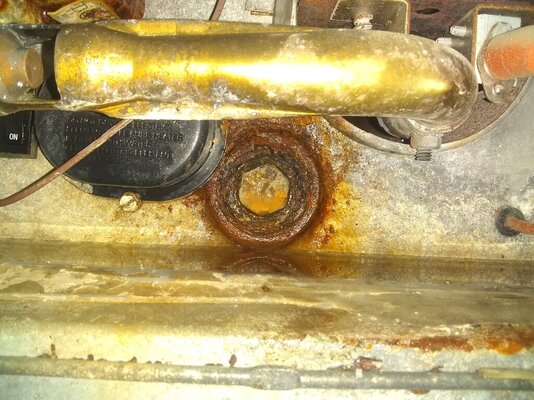Iconoclast
Member
Hi,
This is a thinking cap issue (or at least it has been so far for me...):
I originally thought I had a toilet leak, as water was pooling near the toilet, but I took the channel up that the pipes are running under to get to the toilet, shower, etc. and realized the water had followed the lines. So, I removed the inside panel for the water heater and there were clearly drops coming out of the main water connection to the unit that had pooled in various places in the little cubby the heater sits in. But as I looked closer I realized there was also water coming down two of the walls, and then I noticed the thin board that creates the ceiling (the floor of the cupboard above) was wet on the same side the walls had water on. And then I opened the cupboard above and noticed the water had apparently soaked through from below in a spot where there happened to be a glass jar and the jar had water under it with mold, but no other water anywhere else in the space (and why would there be, as there are no pipes anywhere above that?).
So, aside from the obvious question of where the water is coming from, how did it get ABOVE the water heater? Steam?
Any thoughts on this would be greatly appreciated.
This is a thinking cap issue (or at least it has been so far for me...):
I originally thought I had a toilet leak, as water was pooling near the toilet, but I took the channel up that the pipes are running under to get to the toilet, shower, etc. and realized the water had followed the lines. So, I removed the inside panel for the water heater and there were clearly drops coming out of the main water connection to the unit that had pooled in various places in the little cubby the heater sits in. But as I looked closer I realized there was also water coming down two of the walls, and then I noticed the thin board that creates the ceiling (the floor of the cupboard above) was wet on the same side the walls had water on. And then I opened the cupboard above and noticed the water had apparently soaked through from below in a spot where there happened to be a glass jar and the jar had water under it with mold, but no other water anywhere else in the space (and why would there be, as there are no pipes anywhere above that?).
So, aside from the obvious question of where the water is coming from, how did it get ABOVE the water heater? Steam?
Any thoughts on this would be greatly appreciated.

